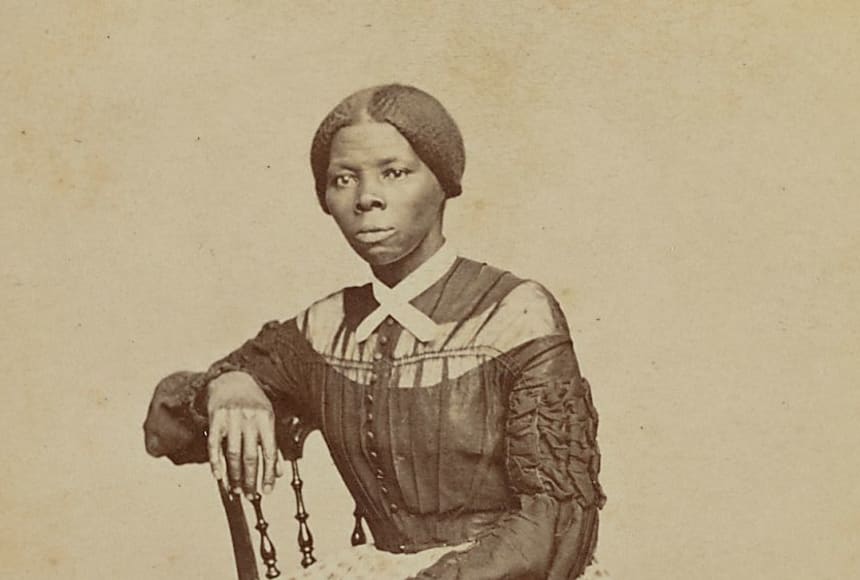While officially recognized as a movement with the involvement of white religious groups, Black activists were always a critical part in dismantling slavery in the United States. These abolitionists—many of them, formerly, enslaved—proved highly influential to advocating for freedom—for themselves and their people. Some participated directly in the rescue of those running away from enslavement, while others swayed public opinion with eloquent speeches and writings in favor of racial equality.
Sojourner Truth
Sojourner Truth was born enslaved in 1797 in Ulster County, New York, before the abolishment of slavery in the state. During her early life, four different people enslaved her. As a teenager, Truth was given to an enslaved man as his wife and together they had five children. In 1826, just one year before a law was passed freeing slaves in the state of New York, Truth fled to the home of a nearby abolitionist, who paid her former enslaver for Truth and her infant child to secure their freedom.
Even though enslaved people in the state of New York were emancipated in 1827, Truth’s young son Peter was sold illegally to an enslaver in Alabama after she was freed. She would go on to sue and become the first African American to win a case against a white man in the U.S. courts, thereby gaining custody of her son.
Moving to New York City, Truth became a traveling minister and advocate against injustices. She would crusade across the East and Midwest as a powerful speaker defending human rights, women’s rights, suffrage, temperance, and numerous other reforms. She would meet and support abolitionist Frederick Douglass and women’s rights advocate Elizabeth Cady Stanton with numerous speaking appearances.
In 1851, Sojourner Truth delivered her most famous speech at the Ohio Women’s Rights Convention in Akron. Not having learned to read or write, the address was impromptu. Her speech, known as “Ain’t I a Woman?” captivated the audience. In her speech, she eloquently campaigned for the advancement of women’s rights and the freeing of all enslaved people.
Harriet Tubman
Harriet Tubman was born on a plantation around 1820 in Dorchester County, Maryland. Life was strenuous and harsh as she labored in the fields of her enslaver. One day when she was an adolescent while visiting the general store, she was caught in the middle of a confrontation between a man running from his enslaver and an overseer. Tubman was struck in the head with a metal weight—possibly by accident, or possibly for intervening on the enslaved man's behalf. The injury was severe and left Tubman suffering from seizures and narcolepsy for much of her life.
Upon the death of her enslaver, there were rumors that Tubman was going to be sold and sent farther south. Harriet fled north until she reached Philadelphia, Pennsylvania. Living in freedom, she observed, “There was such a glory over everything; the sun came like gold through the trees.”
Tubman worked as a domestic servant, cook, and laundress while living in Philadelphia. But, while she enjoyed her freedom, she could never forget those she had left behind on the plantation. Thus, Tubman would make dangerous trips to the South and led others out of their shackles. Historians believe Tubman took as many as 19 trips south and while we may never know the exact number of slaves assisted by her actions, some put the number as high as 300.
As Tubman said in her authorized biography, Harriet, the Moses of Her People by Sarah H. Bradford: “I had reasoned this out in my mind, there was one or two things I had a right to, liberty or death; if I could not have one, I would have the other; for no man should take me alive; I should fight for my liberty as long as my strength lasted, and when the time come for me to go, the Lord would let them take me.”
Frederick Douglass
By his own account, Frederick Douglass was born in Tuckahoe, Maryland, in either 1817 or 1818. As Douglass stated in his first autobiography, Narrative of the Life of Frederick Douglass, “By far the larger part of the slaves know as little of their ages as horses know of theirs, and it is the wish of most masters within my knowledge to keep their slaves thus ignorant.”
Douglass was largely separated from his family as a child, but at around the age of 12, the wife of his latest enslaver—a woman named Sophia Auld—“very kindly commenced to teach me the A, B, C.” However, when her husband discovered what she had done, he forbade her from teaching him further, stating, according to Douglass, “It would forever unfit him to be a slave. He would at once become unmanageable, and of no value to his master.” Although he lost his tutor, the event proved formative for Douglass. “From that moment,” he later wrote, “I understood the pathway from slavery to freedom.”
He continued his education on his own, and eventually, enjoying relatively more freedom than before, began to earn a wage as a laborer—a wage, once received, he had to immediately turn over to his enslaver. In 1838, Douglass escaped from Maryland to New York. His first autobiography, written just seven years after his escape and two decades before slavery was fully abolished, offered no details regarding his escape. His intended wife, a free Black woman named Anna Murray, joined him soon after, and they were married.
Douglass became increasingly involved in antislavery activism, and in 1841, spoke at an antislavery convention on Nantucket Island for the first time. This led to further speaking engagements, and to the publication of his first autobiography in 1845. The book proved to be a bestseller and helped shape many white Americans’ ideas about slavery and the capabilities of former slaves. Douglass later wrote two additional autobiographies, and he was even named as the vice-presidential running mate for women’s rights activist Victoria Woodhull in the 1872 presidential election.
